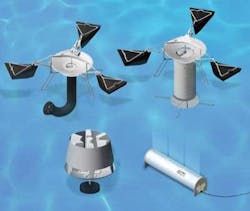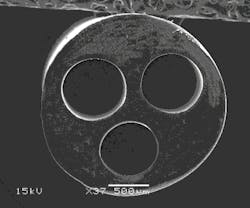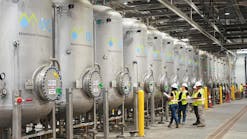By William C. Livoti
There are certain applications where a pumping system must have the ability to control the start sequence as well as vary the flow rate. These applications are high-flow, low-head systems that use synchronous or high pole count induction motors. Typical applications include: circulating water, irrigation, dewatering, flood control, and desalinization.
In many of these applications the start-up and shut down sequence is very harsh on the pump. Often due to the time it takes for the system to achieve hydraulic stability. This article will discuss an innovative solution to improving efficiency, reliability and performance of new and/or existing pump systems.
Motor
High horsepower (above 1000 hp) and low speed (below 700 rpm) pumping applications are unique because the system requires either a high pole count induction motor or a synchronous motor. In both cases the motor will be very large and costly, not only when purchased, but also through the life of the motor.
Another limitation is the motor output speed versus the pump design speed relative to the pump's Best Efficiency Point (BEP). The motor designer is limited to torque requirements which also factors in to the full load speed.
Typical Flood Control Configuration with Vertical Motor.
Pump
The start-up and shut-down sequence of any pumping system is very harsh on the equipment, including the pump, motor and valves. This is due to the time it takes for the system to achieve hydraulic stability, specifically in the case of a long discharge from the water source. This transient condition can and will reduce the pump life by as much as 50%, not to mention the impact on the motor and control valve.
System
The systems identified are typically friction dominated, which require a controlled start. This may consist of a MOV (Motor Operated Valve), bypass or simple manual operation of a block valve. In any case failure to control the start may result in load surge through the system, causing intake structure damage.
Applications
Flood control systems are considered critical service for obvious reasons, and are configured with utility as well as standby power. When standby power is used the system engineer will sometimes incorporate soft starters or variable frequency drives to minimize the impact to the generator.
The pump is typically a vertical single stage unit driven by a high pole count vertical motor or by a right angle gearbox and horizontal four or six pole motor another method is to eliminate the generators and drive the right angle gearbox with a combustion engine.
Each configuration as described has drawbacks:
- The vertical high pole count and or synchronous has a high first cost, high maintenance and requires an electronic soft start of some sort.
- The horizontal motor with right angle gearbox requires a larger foot print, increased installation cost, reduced efficiency due to the double reduction right angle gearbox and the system still requires a soft start mechanism.
- The engine driven package requires the engine to provide the precise speed necessary to meet the pump BEP. Needless to say combustion engines can be large and very noisy especially when contained in a pump house.
There are additional concerns regarding induction motors and reduced voltage starting methods. While reduced voltage starting may help minimize the impact to the power system, there may not be enough torque to accelerate the load to full speed and the motor may stall. Remember the change in torque will vary as the square of the change in voltage.
Planetary Gearbox with Clutch
At 80% speed, the available torque from the reduced voltage start is only 64% of the torque from the full voltage starting method. At that speed, the torque curve of the motor and the load curve are tangent to each other. This is called a stall point, and with this particular motor the load will never reach full speed.
The only way to resolve this problem is to re-design the motor, or increase the size of the motor (at additional cost). It should also be noted acceleration times will be longer (with soft start) than for full voltage starting, due to the reduced starting torque.
Flood control is considered a critical service and reliability is the number one concern. To achieve optimum reliability, while controlling the initial cost, Baldor proposes the usage of a four-pole AC induction motor that is direct coupled to a planetary gearbox. The gearbox features an internal thrust bearing, hydro viscous wet clutch, and a circulating lube oil system to drive the pump.
Key Features
The motor will be directly mounted to the gearbox structure and be connected to the gearbox with a flexible coupling. An integrated wet clutch will allow the motor to achieve motor base speed unloaded. The clutch will then be engaged to gradually bring the pump up to full speed.
The four-pole integral motor/gearbox can be up to 30% smaller than an equivalent high- pole count, low-speed direct drive motor construction. This configuration allows for significantly reduced size and weight, and a reduced cost for the pump driver support structure.
A planetary gearbox and hydro-viscous wet clutch has been designed using Baldor's CST (Control Start Transmission) technology, and provides the speed adjustment of the driven pump during start-up and shut-down. The CST controls the rate of discharge (flow) from the pump, thereby minimizing the hydraulic instability of the system during start-up and shut-down.
The internals consist of two distinct sections, the clutch and the planetary output (See drawing).
1. As the motor reaches full speed, the sun gear rotates the planet gears
2. The planet gears rotate the free floating ring gear
3. The output shaft is integral to the planet carrier and does not turn
4. hydraulic system applies pressure to the annular piston
5. The stationary and rotating plates of the clutch pack are compressed together on their free floating splines
6. This results in application of torque to the ring gear, braking and decreasing its speed
7. This causes the planet carrier/output shaft to increase rotational speed while the planet gears rotate about the ring
8. Ring gear speed reaches zero, the output shaft speed will be at one hundred percent of normal operating speed
The CST and Gearmotor technology allows for a stable, controlled start-up (ramp time is dependent on distance from pump to discharge) and shut-down of the pump. It also protects the pump from potential damage due to obstructions and reduced NPSH conditions.
Typical start-up procedure with CST and Gearmotor solution applied:
- MOV fully Open
- Start motor unloaded (low inrush motor design)
- Engage CST and begin applying power to driven pump
- Slowly accelerate and increase driven pump speed until pipeline is packed and is stable
- Adjust pump speed to final desired flow and pressure
- Monitor/ control speed and flow at DCS
The typical flood control system is friction dominated which is well-suited to a controlled start, especially during an extended start-up sequence, or low water level operation where system demands may fluctuate and NPSHa may be an issue. The wet clutch provides an adjustable torque limiting feature that protects the drive system from any load surge.
Another benefit of the controlled start technology is that the motor can be started unloaded. The no-load start minimizes the duration of damaging locked rotor current when starting a loaded motor. The CST drive system also gives the operator the flexibility of stopping the system without stopping the motor. This avoids multiple motor restarts and subsequent rotor overheating.
In order to control heat generated across the hydro-viscous clutch, the CST is configured with a cooling system. The system is sized to remove the dissipated heat from the relative motion of rotating and stationary plates in the disc pack. The cooling system is either an oil/air, or an oil/water heat exchanger, and is operational only during acceleration.
WW
About the Author: William C. Livoti is senior principal engineer of Power Generation and Fluid Handling at Baldor Electric Co., of Fort Smith, AR. He has over 30 years experience in the pump industry designing, field testing, repairing and troubleshooting mechanical seals, compressors and pumping systems. Livoti is the Vice Chair on the Board of Directors of Pump Systems Matter. He has just completed a book on System Optimization Guide Lines with the Hydraulic Institute and is currently preparing a book on Power Plant Process Guide Lines for Pumping Systems.
More WaterWorld Current Issue Articles
More WaterWorld Archives Issue Articles




